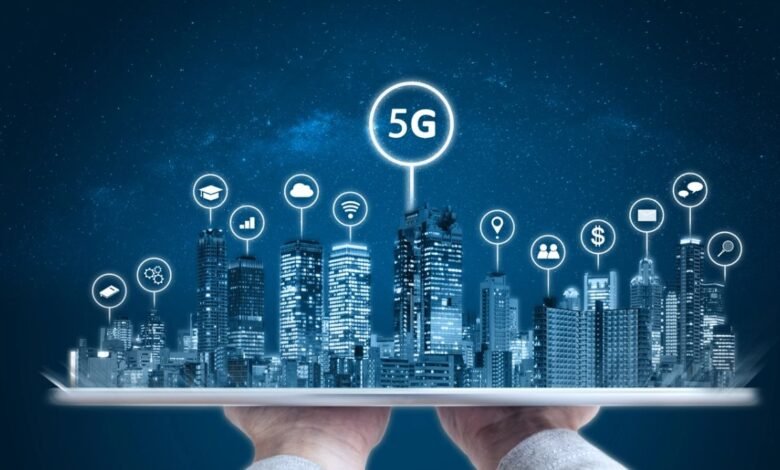How 5G Technology Will Transform Industries

The advent of 5G technology represents a significant leap forward in wireless communication, promising to reshape the landscape of various industries. With its unprecedented speed, lower latency, and ability to connect a multitude of devices simultaneously, 5G is not just an incremental upgrade; it is a transformative force that will redefine how businesses operate, innovate, and deliver value to their customers. In this article, we will explore how 5G technology will transform industries, focusing on its implications for sectors such as healthcare, manufacturing, transportation, and entertainment.
Understanding 5G Technology
5G, or fifth-generation wireless technology, is the latest standard in mobile networks, succeeding 4G LTE. It operates on a broader range of frequencies, including millimeter waves, allowing for faster data transfer speeds that can exceed 10 Gbps under ideal conditions. This remarkable speed enables real-time data processing and communication, significantly enhancing the user experience across various applications. Additionally, 5G technology features ultra-reliable low-latency communication (URLLC), which is critical for applications that require instantaneous feedback, such as remote surgery or autonomous vehicles.
Moreover, 5G technology supports massive machine-type communications (mMTC), allowing billions of connected devices to communicate efficiently. This capacity is crucial for the Internet of Things (IoT), where everyday objects, from household appliances to industrial machinery, can be interconnected to share data and optimize performance. As a result, 5G not only enhances the speed and reliability of mobile communications but also serves as a foundation for a more connected and intelligent world.
Revolutionizing Healthcare
One of the industries poised for profound transformation through 5G technology is healthcare. The integration of 5G in medical settings can lead to breakthroughs in telemedicine, remote patient monitoring, and even robotic surgery. With the ultra-reliable low-latency capabilities of 5G, healthcare providers can perform real-time consultations with specialists located hundreds of miles away. This not only expands access to quality care in rural and underserved areas but also facilitates timely interventions that can save lives.
Remote patient monitoring is another area where 5G will have a substantial impact. Wearable devices equipped with 5G connectivity can transmit vital health data, such as heart rate, glucose levels, and blood pressure, to healthcare providers instantaneously. This constant stream of information enables proactive management of chronic conditions, reducing hospital visits and enhancing patient outcomes. Furthermore, in emergency situations, the ability to transfer high-resolution medical images and data in real-time can significantly improve the decision-making process for first responders and medical teams.
Additionally, 5G technology can support the use of augmented reality (AR) and virtual reality (VR) in medical training and patient care. Surgeons can use AR overlays during procedures for enhanced precision, while medical students can participate in immersive VR training sessions, allowing them to practice complex surgeries in a risk-free environment. The possibilities are vast, and as 5G becomes more widespread, we can expect to see an increase in innovation and efficiency in the healthcare sector.
Transforming Manufacturing
The manufacturing industry is another domain where 5G technology will drive significant change. Known as Industry 4.0, the integration of smart technology in manufacturing processes is already underway, and 5G is set to accelerate this transformation. With its high-speed connectivity, manufacturers can implement real-time data analytics, enabling smarter decision-making and increased operational efficiency.
One of the primary applications of 5G in manufacturing is the enhancement of automation and robotics. Factories can deploy connected machines that communicate with each other seamlessly, optimizing production lines and reducing downtime. For example, if a machine detects a potential failure, it can immediately alert maintenance teams and reroute production to prevent costly delays. This level of connectivity not only improves productivity but also enhances safety by allowing for real-time monitoring of hazardous environments.
Moreover, 5G technology supports the development of digital twins—virtual representations of physical assets. Manufacturers can use these digital twins to simulate and optimize their processes, from design to production. By leveraging real-time data and analytics, businesses can identify inefficiencies and make informed adjustments, leading to reduced waste and improved quality control.
Furthermore, 5G’s ability to connect a vast number of devices simultaneously paves the way for smart factories. Sensors embedded in machinery can monitor performance and gather data on operational conditions, feeding this information back to central systems for analysis. This interconnectedness will empower manufacturers to adopt predictive maintenance strategies, minimizing unplanned downtime and extending the lifespan of their equipment.
Enhancing Transportation and Logistics
The transportation and logistics industry stands to benefit immensely from the implementation of 5G technology. As the world moves towards smarter and more efficient transport systems, 5G will serve as the backbone for innovations such as autonomous vehicles, smart traffic management, and enhanced supply chain visibility.
Autonomous vehicles, including self-driving cars and trucks, require an immense amount of data to operate safely and efficiently. 5G’s low-latency communication allows vehicles to process information from their environment in real-time, responding to road conditions, traffic signals, and obstacles with unprecedented speed. This capability not only improves safety but also optimizes traffic flow, reducing congestion and emissions.
In addition to personal transportation, 5G will revolutionize logistics and supply chain management. Companies can leverage real-time tracking and monitoring of shipments, improving transparency and accountability. Sensors on shipping containers can relay information about location, temperature, and humidity, ensuring that goods are transported under optimal conditions. This level of visibility allows businesses to respond quickly to disruptions, enhancing customer satisfaction and reducing losses.
Furthermore, smart transportation systems powered by 5G can analyze data from multiple sources—traffic cameras, sensors, and GPS devices—to manage traffic more effectively. By optimizing traffic signals and routing, cities can minimize congestion and improve air quality. The integration of 5G technology in public transportation can also lead to enhanced user experiences, with real-time updates on schedules and delays available through mobile applications.
Revolutionizing Entertainment
The entertainment industry is experiencing a seismic shift, driven by technological advancements, and 5G technology is at the forefront of this transformation. With its high data transfer speeds and low latency, 5G will enhance streaming services, gaming, and immersive experiences, allowing consumers to engage with content in entirely new ways.
Streaming services will benefit from 5G’s ability to deliver high-definition and 4K content without buffering. This enhancement will cater to the growing demand for high-quality video, enabling seamless viewing experiences across various devices. Moreover, 5G technology can facilitate augmented reality (AR) and virtual reality (VR) experiences, providing users with immersive environments that were previously unattainable. From virtual concerts to interactive gaming, the entertainment possibilities are vast and varied.
Gaming, in particular, stands to gain significantly from 5G technology. Cloud gaming services will become more prevalent, allowing players to stream games directly without the need for high-end hardware. This democratization of gaming means that anyone with a 5G connection can access and play graphically intensive games on their mobile devices. Furthermore, the low latency of 5G enhances multiplayer gaming experiences, reducing lag and enabling real-time interactions among players.
Additionally, 5G will empower content creators by providing them with advanced tools and capabilities. For example, filmmakers can use 5G connectivity to transmit high-resolution footage in real-time from remote locations, enabling faster production times and collaboration across distances. As the entertainment landscape evolves, 5G technology will play a crucial role in shaping the future of how we consume and interact with media.
Conclusion
The potential of 5G technology to transform industries is immense. From revolutionizing healthcare with remote patient monitoring and telemedicine to enhancing manufacturing with automation and digital twins, the implications are far-reaching. The transportation and logistics sectors will benefit from real-time tracking and autonomous vehicles, while the entertainment industry will see a new era of immersive experiences and seamless content delivery.
As 5G technology continues to roll out globally, its influence will permeate every aspect of our lives, driving innovation and efficiency across sectors. Businesses that embrace 5G will be better positioned to adapt to changing consumer demands and technological advancements, ensuring their competitiveness in an increasingly digital world. The future, powered by 5G, promises to be more interconnected, efficient, and dynamic than ever before.



